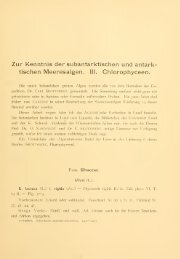Download PDF
Download PDF
Download PDF
Create successful ePaper yourself
Turn your PDF publications into a flip-book with our unique Google optimized e-Paper software.
126 ZYGNEMATACEAE<br />
cells, or the thickening may be unequally distributed and modify<br />
the usual cell form. (PI. I, Fig. i.) Aplanospores are formed by<br />
the contraction of the contents of vegetative cells and the growth<br />
of a new and distinctive spore wall.<br />
The "spore wall" is really a complex of three to five walls, one<br />
or more of which may be variously sculptured or ornamented.<br />
The outer wall is of cellulose and is usually colorless and trans-<br />
parent. Sometimes the outer wall is made up of two colorless<br />
layers, either of which may be thick and sculptured. The median<br />
spore wall at maturity is distinguished by its yellow to chestnut<br />
brown color resulting from chitinous deposits in or on the cellu-<br />
lose. This is the spore wall most frequently sculptured and ornamented.<br />
In some species the median wall also consists of two<br />
distinct chitinous layers. The inner spore wall is a thin cellulose<br />
layer lining the median wall and seldom seen, except when the<br />
spores are crushed. The median and the outer walls have a suture,<br />
more or less distinct, encircling the spore. At the time of germi-<br />
nation these walls split along this line, while the inner wall<br />
enlarges with the protoplast and becomes the wall of the one<br />
celled sporeling. The walls of zygospores are similar to those of<br />
aplanospores.<br />
The forms of Spirogyra spores are of three general types:<br />
ellipsoid (like an American football), ovoid (like a watermelon),<br />
and lenticular (a compressed spheroid). These forms may be<br />
slightly modified by elongation or compression but the curvatures<br />
of the polar ends remain the same. Usually there is no difficulty<br />
in recognizing the spore form of the 155 species with ellipsoid<br />
spores, and the 77 species with ovoid spores. There are 13 species,<br />
however, in which there is greater variation, and the form may<br />
be on either side of the border line between ovoid and ellipsoid.<br />
These are usually cared for in the keys by listing under both types.<br />
Compressed-ellipsoid, and compressed-ovoid spores are rare but<br />
do occur. The deviation of "lenticular" spores (30 species) from<br />
the form of a sphere may be as slight as an orange, or as great as<br />
a pocket watch. Obviously such spores are nearly circular in face<br />
view, and ovoid in side view.<br />
Conjugating tubes are usually formed by both gametangia<br />
(228 species) but in 31 species they are outgrowths of the male<br />
gametangia. In a few species in which the receptive gametangia<br />
become greatly distended the part of the tubes formed by them




